As someone fascinated by historical fashion, I often find myself drawn to the elegance of Victorian gowns. However, being rooted in the American Southwest, I’ve also developed a deep interest in the clothing worn by pioneer women. This blend of interests has led me to explore how fashion on the Western frontier differed from the established styles of Eastern cities during the 19th century. Let’s delve into the world of Pioneer Women Clothing and uncover the practical yet stylish wardrobes of these remarkable women.
For this exploration, we’ll focus on the period roughly from 1850 to 1890, west of Missouri and Arkansas. We’ll be examining the clothing of women homesteaders and those in settlement communities, primarily white settlers who journeyed westward. What’s particularly captivating is that frontier clothing was less about social status and more about the shared experience of pursuing dreams and exploring the unknown.
Underpinnings of Pioneer Style: Underclothes
Surprisingly, the foundation garments of pioneer women clothing weren’t drastically different from those worn in eastern cities. The chemise, a simple, light cotton slip, was a fundamental piece, prioritized for hygiene and frequent washing. Pantalets, made of flannel or cotton, followed, serving modesty purposes – a precursor to modern underpants.
Despite initial assumptions, corsets were indeed a part of the pioneer woman’s wardrobe. Many women venturing west were driven by aspirations for a better life, whether for economic or religious reasons. They were “proper” women who upheld the standards of their time, and corsets were considered essential for maintaining that propriety.
While the rigors of frontier life might have led some to loosen or forgo corsets during strenuous tasks, most pioneer women brought corsets and wore them whenever possible.
Petticoats, another cherished garment, were layered over the corset. Like dresses, women owned multiple petticoats for varying levels of formality and weather conditions. Stockings were indispensable when leaving the house or receiving guests, often secured with garters or tucked into pantalets – a detail that might seem rather uncomfortable today!
Fabrics of the Frontier: Practical Choices
Calico reigned supreme as the fabric of choice for pioneer women clothing. Often envisioned as quaint floral patterns, calico is actually a type of plain-woven, unprocessed cotton, slightly lighter than canvas. Its lightness, sturdiness, and ease of cleaning made it ideal for the demands of outdoor life. Available at general stores in dyed options, or dyed at home using store-bought or natural dyes from plants, calico was versatile and practical.
Cotton and silk still held their place for “Sunday best” and more formal dresses, and many women brought such garments from their previous homes.
While fabrics became accessible through general stores, availability varied greatly depending on location. In remote areas, families often had to create their own fabrics – a craft deserving of its own exploration.
Daily Wear: Adapting to Frontier Life
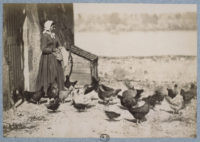
Regardless of their backgrounds, women in frontier settlements actively participated in establishing and maintaining homes and farms. Cooking, cleaning, childcare, laundry, and even field work filled their days. Family survival depended on everyone’s physical contributions, with no room for outsourcing domestic labor. Frontier women quickly adapted to a life of manual labor, and their daily wear reflected this reality.
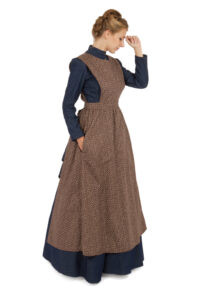 Pioneer Calico Apron
Pioneer Calico Apron
The prevailing dress styles of the time, fitted bodices and full skirts, were adopted by pioneer women but with practical modifications. Skirts for everyday dresses were hemmed approximately three inches shorter to facilitate movement. Weights might be sewn into the hems to prevent them from blowing up in windy conditions.
Bodices remained fitted, but sleeves became looser, extending to the wrists, paired with high collars for sun protection.
Laundry was a significant task for pioneer women clothing. The book How the West Was Worn mentions “wash dresses”—practical two-piece dresses of white cotton with printed patterns that gained popularity around 1867 due to their easy care. These “wash dresses” were adopted across socioeconomic levels, highlighting how fashion adapted to the practical needs of frontier life.
Sunday Best: Dressing for Church and Community
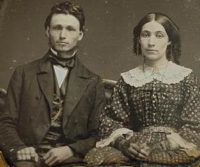
Even in sparsely populated areas, settlements often had churches, and church attendance was a vital part of community life. While accounts exist of women in impoverished communities attending barefoot, it was more common for women to have a designated “Sunday best” dress or two. Historical records are more abundant regarding more privileged settlers, making it challenging to determine the most typical scenario.
“Sunday best” pioneer women clothing closely mirrored fashionable city styles. Full skirts over petticoats and corsets were standard, and sleeves featured fashionable puffs like bell, leg-o-mutton, or pagoda styles, depending on the era. Skirt styles also followed trends, ranging from crinoline to hoop and bustle as decades progressed.
Lighter colors were favored by younger and newly married women, transitioning to darker shades after a few years. Sunday ensembles were completed with the most fashionable hats available, along with kid gloves and low-heeled boots.
Socializing on the Frontier: Roundups, Balls, and Parties
When means allowed, pioneer women reserved dresses specifically for social occasions beyond daily and Sunday wear. Dances, holiday celebrations, picnics, and other gatherings were important for community bonding, and women dressed accordingly, much like their Eastern counterparts.
 Mary Chestnut’s Americana Victorian Cotton Dress
Mary Chestnut’s Americana Victorian Cotton Dress
These social dresses were highly valued. Women might order fabrics from general stores and eagerly await the chance to create fashionable outfits. Godey’s Ladies Book was a significant source of inspiration, with patterns and styles eagerly copied and shared among frontier women.
Fabric availability for new dresses depended heavily on proximity to towns and general stores. In more isolated areas, women might have had a limited wardrobe, adapting their best dress for special events with added embellishments. Hand-crocheted collars and shawls were popular options, along with other accessories.
Accessorizing on the Frontier: The Finishing Touches
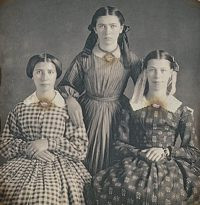
Accessories played a crucial role in pioneer women clothing. Beyond skirts and calico, the finishing touches were highly significant. Jewelry and accessories were emphasized throughout historical accounts, highlighting their importance in a frontier woman’s wardrobe.
Pioneer women accessorized with:
- Aprons
- Boots
- Brooches
- Lockets
- Earrings
- Precious stones and metals
- Hair adornments
- Hats
- Collars and cuffs
- Gloves
- Undersleeves
- Parasols
- Fans
- Handbags
- Shawls
A Lasting Legacy of Pioneer Fashion
Exploring the lives of my own pioneer ancestors sparked a deep fascination with this era. While “prairie style,” “pioneer,” and “western wear” clothing are readily available today, understanding the historical context of how pioneer women balanced propriety, beauty, and fashion amidst challenging physical demands is truly captivating.
This exploration of pioneer women clothing reveals a world where practicality and style intertwined. Stay tuned for a follow-up post delving deeper into accessories in the frontier.
Recreate the Pioneer Look:
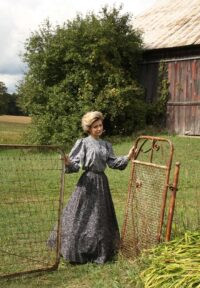 Woman in pioneer clothing standing in a field wearing a long-sleeved blue top and long blue skirt.Pioneer Calico Blouse and Skirt
Woman in pioneer clothing standing in a field wearing a long-sleeved blue top and long blue skirt.Pioneer Calico Blouse and Skirt
Browse our pioneer clothing collection
Pioneer Calico Blouse and Skirt
Harper Victorian Pioneer Dress
Pioneer Blouse, Apron and Skirt
